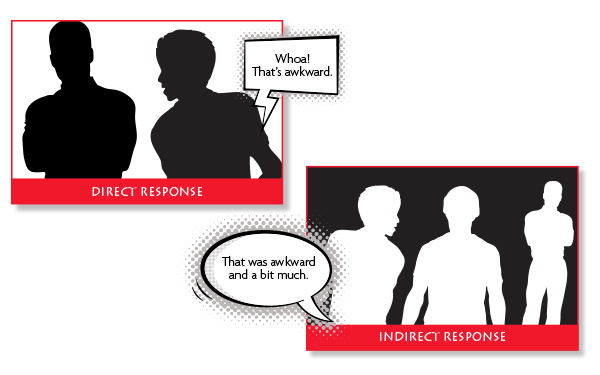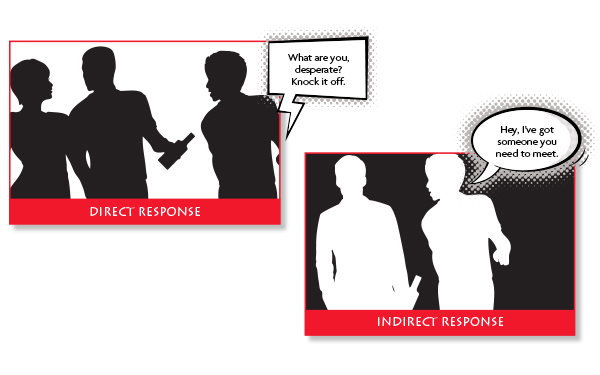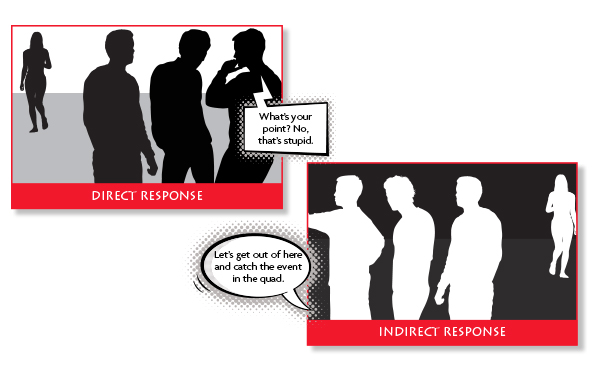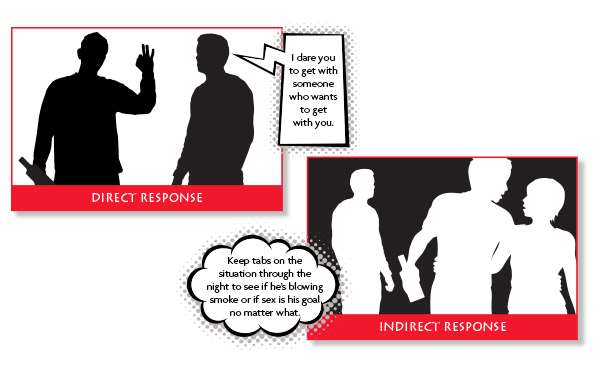“A gradual better”: One student’s story of dealing with suicidal thoughts
Reading Time: 7 minutes Learn the warning signs and what you can say or do if someone you know is considering suicide.
Reading Time: 7 minutes Learn the warning signs and what you can say or do if someone you know is considering suicide.
Reading Time: 4 minutes Here’s everything you need to know about the coronavirus (COVID-19), including symptoms, who is most at risk, and what you can do to help stop the spread.
Reading Time: 3 minutes October is Breast Cancer Awareness Month. Here’s how to do a breast self-check.
Here’s something most of us know, and the research backs up: Small actions make a big difference, especially when it comes to preventing sexual harassment and assault. If we see something that doesn’t feel right, we can act. This is bystander intervention: stepping in to reinforce our community values and prevent harm when we see something that looks like disrespect or pressure. Many of us already do this, like when we disrupt a conversation that seems uncomfortable or speak up when people make hurtful comments.
Often, when we think about sexual misconduct and bystander intervention, we’re thinking about intervening in social situations, such as on the dance floor, at a party, or in a relationship. But what happens when you see this happening at your internship, on the job, or at your workplace?
While we might know that it’s equally important to take action in the workplace, we might not exactly know how to do it, especially if we’re dealing with uneven power dynamics—like a boss who’s making crude comments to an employee or an established colleague taking advantage of a new intern. The good news? The basics, which you already know, work here too.
“The skills and strategies that work in social contexts can often be applied to other settings, including professional contexts such as a summer internship or other job,” says Laura Santacrose, assistant director of the Skorton Center for Health Initiatives at Cornell University in New York, who developed Cornell’s “Intervene” project, a bystander intervention initiative for students. The knowledge and confidence that we’ve gained from intervening in other contexts make a difference. Knowing we have the skills to step in makes us more likely to do so, according to a 2014 study of college students in the Journal of Interpersonal Violence.
Besides reinforcing your own personal values, you’re also setting the bar high for the rest of the organization. And that’s important. “Employers hope to create an environment that is welcoming and inclusive for all employees. A safe and inclusive environment fosters teamwork among colleagues, greater workplace satisfaction, and higher levels of innovation and creativity on the job. Employees who are able to facilitate such an environment are highly valued by both their employers and by their clients,” says Jeanine Dames, director of the Office of Career Strategy at Yale University in Connecticut.

So how do you do it?
Whenever we intervene, it’s critical to consider the potential risks involved and to make a safe plan. The power dynamics between supervisors and employees may make it difficult to intervene directly, so consider subtle or indirect actions. “There may be additional supports in a professional setting that will make an intervention easier [than in a social situation], including support from a human resources department,” says Santacrose.




Now that you know the basics, or at least can refer back to them, let’s get into some examples. Use the following scenarios to think about possible intervention strategies. What strategies would you choose?
Scenario 1: Inappropriate jokes
Imagine that you share an office space with several other summer interns. One of the interns, Taylor, often makes sexual jokes and suggestive comments. You and the other interns find the jokes annoying, but one of the interns, Sam, looks upset and starts to avoid the space.
Scenario 2: Unfair treatment
Imagine that you have a part-time campus job in a lab. The professor in charge of the lab chooses a graduate student, Riley, to lead a project. A few weeks ago, Riley asked one of your coworkers, Casey, out on a date. Casey said no. Since then, Riley seems to be treating Casey differently from the other lab members. Riley often dismisses Casey’s comments in meetings and assigns all the menial jobs to Casey.
Scenario 3: Callouts on appearance
Imagine that you have a part-time job. Your supervisor makes small talk with employees as you arrive in the morning. Topics range from sports to the weather, but on several occasions, your supervisor has made comments about the appearance of one employee, Kai, such as, “You look gorgeous today!” and “That shirt looks great on you!” Your supervisor does not comment on other employees’ appearances.
See? Your bystander skills just went pro. When you break it down like this, intervening becomes a little easier, which means your workplace can be just as supportive of a community as your campus is. So remember: Your bystander skills can work in any context, at any time.
Want more bystander info? Check out Cornell University’s bystander initiative, “Intervene.” This interactive training, useful for students of all kinds, offers concrete strategies for intervening in a wide range of social, academic, and professional settings.
Strategies developed by the Communication and Consent Educator program at Yale University.
[school_resource sh101resources=’no’ category=’mobileapp,healthservices, wellnesspromotion, counselingservices, titleix’] Get help or find out more
“Intervene” video and resources on bystander intervention: Cornell University
Brochure on effective intervention strategies: Yale University
[survey_plugin]
Article sources
Jeanine Dames, JD, director of office of career strategy, Yale University, Connecticut.
Laura Santacrose, MPH, assistant director, Skorton Center for Health Initiatives, Cornell University, New York.
Banyard, V. L. (2011). Who will help prevent sexual violence: Creating an ecological model of bystander intervention. Psychology of Violence, 1(3), 216–229.
Banyard, V. L., Plante, E. G., & Moynihan, M. M. (2004). Bystander education: Bringing a broader community perspective to sexual violence prevention. Journal of Community Psychology, 32(1), 61–79.
Bennett, S., Banyard, V. L., & Garnhart, L. (2014). To act or not to act, that is the question? Barriers and facilitators of bystander intervention. Journal of Interpersonal Violence, 29(3), 476–496.
Bowes-Sperry, L., & O’Leary-Kelly, A. M. (2005). To act or not to act: The dilemma faced by sexual harassment observers. Academy of Management Review, 30(2), 288–306.
Carmody, M. (2005). Ethical erotics: Reconceptualizing anti-rape education. Sexualities, 8(4), 465–480.
Garcia, S. M., Weaver, K., Moskowitz, G. B., & Darley, J. M. (2002). Crowded minds: The implicit bystander effect. Journal of Personality and Social Psychology, 83(4), 843–853.
McDonald, P., Charlesworth, S., & Graham, T. (2016). Action or inaction: Bystander intervention in workplace sexual harassment. International Journal of Human Resource Management, 27(5), 548–566.
McMahon, S., & Banyard, V. L. (2012). When can I help? A conceptual framework for the prevention of sexual violence through bystander intervention. Trauma, Violence, & Abuse, 13(1), 3–14.
Rayner, C., & Bowes-Sperry, L. (2008, June). Mobilizing bystanders to intervene in workplace bullying. In The 6th International Conference on Workplace Bullying.
Rate this article and enter to win
Going to a party? Or throwing one? Party-throwers and party-goers play a vital role in shaping the sexual culture of your campus. Party-throwers are the social engineers who design the spaces in which students meet, dance, talk, and sometimes drink or hook up. A well-planned environment helps everyone to make mindful decisions. And as a party guest, you can do a lot to make this easier for your host and more fun for yourself and others. Every time you demonstrate mutual respect, you reduce the likelihood of campus sexual assault and/or alcohol poisoning. Here’s how to throw a great party and be a great guest.
The minimum legal age for consuming alcohol in the US is 21.


Set the tone
How you talk about a party can go a long way in helping your guests imagine what it will be like. What’s the tone or vibe you want for your party? For example:
Set expectations
Are there “house rules” you want your guests to know about? For example:

Set a friendly tone
Consider explicitly assigning someone (or a few people) the task of greeting guests and inviting them in.
House rules
If there’s stuff your guests need to know, like when this thing is shutting down, consider posting it in the entryway.
Check in with arriving guests
Are they arriving alone? Slurring their words? Wobbly on their feet? You might want to check in with someone’s friends, get them medical attention, or not serve them any more alcohol.
Send people home safely
Make sure your guests have a safe way to get home. Check in with them as they leave. Post info about taxi and ride services, as well as medical response resources in case of accidents or alcohol poisoning.

Here’s why that works out better for you:
Check in with your neighbors
Check in with your campus security department
Check campus policies and state laws

Not everyone has fun the same way all the time.
Dance space
When you’re putting together the playlist or choosing entertainers or DJs, think about how well they fit your values and priorities for the party. Avoid music that seems derogatory or aggressive.
Chill space
Provide a quieter, more well-lit space where your guests can hang out, catch their breath, and talk. Play softer music. It’s a good idea to stock this space with cold water bottles and low-salt, high-protein snacks.
A set-up that makes room for conversation will help your guests communicate more clearly. This is especially important if two people are considering going home together.
Think about adding activities (apart from dancing) that don’t involve alcohol, like Jenga®, board games, and trivia.

If there are isolated spaces in your party venue, decide whether or not to keep them open and accessible.
If not: Lock the door, rope off the space, and/or hang signs saying the space is closed.
If you keep isolated areas open, assign someone the task of checking in on those spaces throughout the party.

Get medical help in case of alcohol poisoning
Take a moment to familiarize yourself with the medical response resources available on your campus or in your community. If everything goes according to plan, your guests will drink safely and won’t need to use them.
Any of the following symptoms indicates alcohol poisoning
Call for medical help immediately:
Handle difficult guests
Keep your cool. Controlling tone and body language can be tricky, but it’s crucial to prevent the situation from escalating further.

Make yourself noticeable
Pick a certain color, a silly hat, or a large pin (“Here to help!”). This lets guests know where to turn if anything comes up. If a large group is throwing the party, consider trading off “hosting duties” through the evening.
Model supportive social dynamics
Party-throwers are especially attuned to the general mood. You get to take the lead on looking out for one another and treating guests with respect. If you drink alcohol, stop after one or two.
Make the rounds
Introduce people and troubleshoot issues as they come up.
Check isolated spaces, such as bedrooms, closets, and yards.
Subtly disrupt uncomfortable situations
Maybe a guest is getting unwanted attention or someone is pressuring others to drink. It’s your party: You can check in whenever you notice something, no matter how small. The most effective interventions happen early and subtly. Distract people, change the topic, make a joke or an introduction.

If you plan to serve alcohol, aim for an environment in which everyone can make mindful, deliberate choices about whether they want to drink and how much. A successful party does not have to involve alcohol.
If you serve alcohol:

For guests, this set up makes drinking an active choice rather than a default. It’s easier for people to count their drinks over the course of the evening.
Designated servers are awesome at these party skills:
Many campuses and community organizations offer classes on bartending skills and safe serving practices—often for free.


Notice the tone
The invitation (whatever form it takes) should give you some idea of what your hosts have in mind. Big house party? Chill get-together?
Respect their house rules
Validate the hosts’ trust in you. They might want to keep certain areas off-limits, or they may need to end things at a certain hour.
Plan ahead
Think about what you want out of the party. If alcohol will be served: Do you want to drink? How much? You can have a great time at any party without drinking any alcohol. If you do plan to drink, a good rule of thumb is one standard drink every hour or 1½ hours.
Be a good sport about the theme
If your hosts have gone through the trouble of coming up with a theme, do your best to play along. A good theme will make room for everyone to participate in whatever way they feel comfortable, so feel free to find your own.

Get in touch with your host at least a day in advance. Do they need help setting up? Or staying late to help clean up? This a great way to show your appreciation.
If you want to bring something, consider snacks (preferably low-salt and high-protein ones, like Greek yogurt dip or hummus with veggies) or mixers. These go quickly at parties, and your hosts will appreciate having extras.

Find the host when you arrive
You’re here to see them, and they’ll be happy to know you made it. Ask if they could use a hand with anything.
If you don’t know many people there, tell your host
They want you to have fun. They probably have a good sense of who you’ll get along with, and can introduce you.
If you see new faces in the room, say hello
Offer to show them around, and introduce them to other guests. You’ve been that newbie—remember the relief when someone made you feel welcome in a new space.
If you’re the newbie, branch out

Fun means different things to different people. Some people would rather hang out and talk than spend the night on the dance floor. Some people will be more comfortable getting physical than others. Whatever it is, pay attention to the cues you’re getting, and respect them.

If you notice a troubling dynamic, think about how best to step in
Perhaps you notice someone experiencing unwanted attention or being pressured to drink more than they want to. Maybe you see some broken glass or someone in need of medical attention.
Whatever it is, there’s always something you can do
This is your community, and you play an important role in making it a positive and supportive one. You could:
If you’re worried that your friend is pressuring others
This can be a great opportunity for a stealthy intervention—for example, by joining a conversation or people on the dance floor. If you’re close to your friend, you can always demand that they consult you about something important in the other room.

People have different limits when it comes to alcohol
Many people make the decision not to drink alcohol at all. Pressuring someone to drink beyond their limit puts them at risk and creates more work for your host. That guest who drinks too much may get sick, need medical attention, or be unable to get home safely.
Trust your own limits
Be especially cautious if you are stressed or sleep-deprived, taking medication, have alcohol misuse in your family, or have diabetes. If you’ve chosen to drink alcohol, remember to pace yourself so that you’re sober enough to enjoy the party and the company of your friends. Tips for drinking safely:
Include people who don’t want to drink

Thank the host for a great party
Ask if they need anything before you head out: Can you lend a hand cleaning up? Can you walk someone home or give them a ride?
Don’t leave your host in the lurch
If your host is dealing with drunk or unruly guests, ask what you can do to help. Maybe you could suggest that everyone head out for pizza, help find the stragglers’ friends, or offer them a ride home.

Thank your host
They’ll be happy to hear what you enjoyed. If their party planning supported different ways to have fun, say how much you appreciated it.
Check in with anyone you may have been concerned about at the party
How to party smart: Harvard Drug and Alcohol Peer Advisors
Skills for safe alcohol consumption: TIPS®
What you can do to help: Who Are You?
Find local services for sexual assault survivors: NotAlone.gov
Get active against sexual assault: Know Your IX
Bystander tips and training: University of Arizona (Step UP! Program)
Melanie Boyd, PhD, assistant dean in student affairs at Yale University; lecturer in women’s, gender, and sexuality studies.
Abbey, A. (2011). Alcohol’s role in sexual violence perpetration: Theoretical explanations, existing evidence, and future directions. Drug and Alcohol Review, 30(5), 481–489.
Abbey, A. (2002). Alcohol-related sexual assault: A common problem among college students [Supplement]. Journal of Studies on Alcohol and Drugs, 14, 118–128.
Benson, B. J., Gohm, C. L., & Gross, A. M. (2007). College women and sexual assault: The role of sex-related alcohol expectancies. Journal of Family Violence, 22, 341–351.
Banyard, V. L., Plante, E. G., & Moynihan, M. M. (2004). Bystander education: Bringing a broader community perspective to sexual violence prevention.
Journal of Community Psychology, 32(1), 61–79.
Bay-Cheng, L. Y., & Eliseo-Arras, R. K. (2008). The making of unwanted sex: Gendered and neoliberal norms in college women’s unwanted sexual experiences.
Journal of Sex Research, 45(4), 386–397.
Carmody, M. (2005). Ethical erotics: Reconceptualizing anti-rape education. Sexualities, 8(4), 465–480.
Hingson, R. W. & Howland, J. (2002). Comprehensive community interventions to promote health: Implications for college-age drinking problems.
Journal of Studies on Alcohol Supplement 14, 226–240.
Lindgren, K. P., Pantalone, D. W., Lewis, M. A., & George, W. H. (2009). College students’ perceptions about alcohol and consensual sexual behavior: Alcohol leads to sex.
Journal of Drug Education, 39(1), 1–21.
Mohler-Kuo, M., Dowdall, G. W., Koss, M. P., & Wechsler, H. (2004). Correlates of rape while intoxicated in a national sample of college women.
Journal of Studies on Alcohol and Drugs, 65(1), 37–45.
Sweeney, B. N. (2011). The allure of the freshman girl: Peers, partying, and the sexual assault of first-year college women. Journal of College & Character, 12(4).
Rate this article and enter to win
All students have a vital role in the effort to build safer and socially comfortable campuses. Research shows that only a small number of men on campus are responsible for most of the sexual assaults. “The truth is many more men would prefer to interrupt this stuff than buy into it,” says Lee Scriggins, an expert in bystander intervention education at the University of ColoradoBoulder. Much of the time, it’s not even about preventing a potential assault. “We ask students to act when they see anyone looking even a bit uncomfortable. By making bystander intervention low-key and routine, we create a safety net that also supports mutuality and respect. Everyone has a role to play,” says Melanie Boyd, assistant dean of student affairs at Yale University, Connecticut.
“For men, feeling that you have to solve the whole situation, and that confrontation will result in a fight, is a barrier,” says Scriggins. Bystander intervention efforts emphasize a range of direct and indirect ways to help make sure everyone is comfortable. These include resisting other people’s derogatory comments, which signal a potentially toxic environment, and creating openings for someone to extract themselves from a situation if they want to…
What you can achieve:
A classmate makes a sexually suggestive comment to another student

At a party, a guy seems to be paying way too much attention to another student

Walking across campus with friends, a student suggests you all follow someone

A drunk guy announces he’s going to get with a girl that night

Get help or find out more
Which sexually transmitted infection (STI) is making a comeback?
What’s up?
Syphilis rates. They’ve nearly doubled since 2005, and approached 17,000 new cases in 2013, says the CDC.
In whom?
Men (90 percent of cases)—especially men who have sex with men (75 percent of cases).
How is this happening?
Via skin-to-skin contact during sex.
How can we stop it?
Condoms, dental (oral) dams, STI screening, abstinence.
Which dead celebs had syphilis?
Bram Stoker, Henry VIII, and Vincent Van Gogh, according to Medscape.